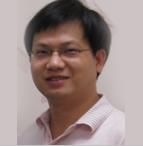Invited Speaker--Dr. Tao Gong

Professor, College of Information Science and Technology, Donghua University, China
Prof. Tao Gong received the MS degree in Pattern Recognition and Intelligent Systems and PhD degree in Computer Science from the Central South University respectively in 2003 and 2007. He is a professor of immune computation/computational immunology at Donghua University, China, and he was a visiting scholar at Department of Computer Science and CERIAS, Purdue University, USA. He is the General Editors-in-Chief of the first leading journal Immune Computation in its field, and an editorial board member of some international journals. He was a Technical Committee Chair of ISEEIP 2012, and a Publicity Chair of ISA 2012 and ICSI3 2015. He was Invited Speaker for some conferences such as SecTech 2012, ICAMR 2014, ITA 2016 and CSA 2016. He was also a program committee member of some international conferences such as IEEE ICNC 2011, IEEE BMEI 2011, WMSE 2011, ICARIS 2012, AITS 2012, CCA 2012, ASP 2012, IST 2012, ISA 2012 and SIS2013 etc. He is a Life Member of Sigma Xi, The Scientific Research Society, a Vice-Chair of IEEE Computer Society Task Force on Artificial Immune Systems (2012-2018), and Chen Guang Scholar of Shanghai. His research has been supported by National Natural Science Foundation of China, Shanghai Natural Science Foundation, Shanghai Educational Development Foundation and Shanghai Education Committee etc. He has published over 100 papers in referred journals and international conferences, and over 20 books such as Artificial Immune System Based on Normal Model and Its Applications, and Advanced Expert Systems: Principles, Design and Applications etc. His current research interests include computational immunology and immune computation. He is also a committee member of intelligent robots committee and natural computing committee in the Association of Artificial Intelligence of China.
Speech Title: Intelligent Modeling and Visual Simulations of Immune Systems Against Diseases
Abstract: In order to analyze immune systems against such as the thyroid disease, the brain tumor, the Ebola virus disease, the tuberculosis, the lung disease, the pneumonia, the SARS disease and the hepatitis B disease, the medical images of the diseases were pretreated and processed with anti-noise histogram correction, image enhancement and image segmentation. The medical images were grayed by adjusting the color distribution ratio, according to the gray value formula. The binary medical images were represented with the vectors of x-axis and y-axis, according to the vector formula. Through the histogram correction, the pixel values of the medical images were distributed at all levels, and the gaps between the pixel values were widened to show image more details more easily. Based on both the foreground ratio and background ratio, an iterative threshold segmentation method was proposed for human thyroid images. This method was improved on the basis of gray threshold segmentation and edge detection, and the Sobel operator was used in the proposed medical image segmentation algorithm. The visual intelligent simulations (
http://ic.ytxxchina.com) of the immune systems against the diseases were built with Java tools such as NetLogo to simulate the biological medical reaction and explain the reasons. The repeated experiments and comparison show that the proposed Sobel-operator-based image segmentation algorithm can retain more information from the medical images with better edge detection. The proposed image segmentation algorithm is useful to improve the quality after image segmentation for better medical diagnosis. The proposed visual simulation approach of the immune systems against the diseases is useful to analyze the diseases and the immune responses better.

